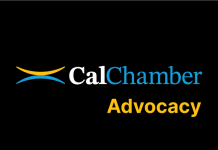In this episode of The Workplace podcast, CalChamber President and CEO Allan Zaremberg and Albertsons Companies Senior Vice President of External Affairs and Chief Diversity Officer Jonathan Mayes discuss the importance of diversity and inclusion in the workplace, and provide best practices to help foster a diverse workforce, which will help the company succeed.
Mayes, who also is a member of the CalChamber Board of Directors, tells Zaremberg there are many benefits of employing a diverse and inclusive workforce, and one benefit is that diversity helps businesses be more successful.
Research consistently shows that companies which embrace diversity and inclusion outperform those that don’t. For example, Mayes says, research has shown that companies in the top quartile for gender diversity are 21% more likely to experience above-average profitability and companies in top quartile for race and ethnic diversity are 33% more likely to experience above-average profitability, compared with companies in the lowest quartile.
One way to drive home the importance of diversity in the workplace to management teams is to make the business case for it, he tells Zaremberg.
Why Teaching Diversity Can Be Hard
Teaching the importance of diversity and inclusion can be hard because of the reality of unconscious bias, Mayes explains.
“It’s the reality that our minds can take in about 11 million pieces of data in any split second, but at a conscious level we are only aware of about 40,” he says. “And so we reach conclusions about people—who we want to hire, who we might want to promote, [and] who we might want to develop, if you will, to help them in their career.”
And sometimes, Mayes points out, a manager will hire or promote someone over someone else without even realizing that bias factored into the decision.
Albertsons’ Training Model
To address unconscious bias, Albertsons Companies has developed training to help the organization’s 300,000+ workforce understand that diversity is something to continually strive for, instead of thinking of training as “one and done” or as a box you check and then forget about, Mayes explains.
Part of Albertsons Companies’ training includes “behavioral nudges” or reminders of the benefits of diversity and inclusion, and what management teams can do to lessen the likelihood of bias.
Zaremberg points out that company leadership should remind those within the company that diversity is good for business and is therefore good for investors.
“…We can’t stay in business unless we are successful and here is a good approach, and [an] underlying foundation to success is diversity,” Zaremberg says.
Albertsons Companies, Mayes explains, started diversity and inclusion training with company leaders, followed by group meetings at which he discussed the business case for increasing diversity, and shared personal stories of what it felt like to be discriminated against for no other reason than for the color of one’s skin.
After this training, the organization began 25-minute-long interactive training modules that walked people through presentations and required them to answer questions correctly before moving on. Module participation was required not just of management teams, but of every employee, Mayes says. Now, the modules are part of new hire training.
Additionally, the Albertsons Companies continues follow-up training periodically.
Resources
Organizations and companies that wish to increase workforce diversity may want to hire a consultant, Mayes says, but if the company is unable to, there are many online and YouTube sources which can provide resources and ideas on how to accomplish workforce diversity. Two organizations that also can help provide resources and guidance are McKinsey & Company and Lean In.
Mayes also recommends that employers read two books: Blindspot: Hidden Biases of Good People by Anthony Greenwald and Mahzarin Banaji, and White Fragility by Robin DiAngelo.
Mayes explains that both books can really open one’s eyes about bias, and the books suggest steps to lessen the impact of bias.
Have Courageous Conversations
It’s also important, Mayes says, to have courageous conversations about race and diversity. During the recent protests concerning George Floyd’s death, Albertsons Companies’ CEO held a virtual town hall with many African American associates within the organization, to learn about their experiences and listen to their recommendations.
Having these conversations, Mayes tells Zaremberg, cultivates a workforce culture which increases the understanding of the realities of bias. It also shows employees that the company values them and cares about their opinions. Employers should ask what more they could do to make their employees feel welcome, respected and valued.
It’s about making sure you understand your coworkers and the shoes they walk in, Zaremberg adds.
Practice
Having the best of intentions is not enough, Mayes points out. Employers need to ensure there is a structure in place in order to foster meaningful change and diversity. For example, employers should examine the percent of people of color or women in their leadership and management teams. Is there diversity within the company’s hiring panels?
Research indicates that if one out of four job candidates is a woman, and if everyone on the hiring panel is male, the chances of the woman candidate getting the job is nearly zero, he says.
“The reality is that there is bias and until you have different structures in place, it’s going to be very hard to change it,” he tells Zaremberg.
On the other side of the ledger, Mayes continues, employers should actively strive to find underrepresented groups in their job candidate pools.
Getting a diverse selection of candidates into the final slate of interviewees will start to move the needle so that management reflects the demographic of the community being served, Mayes says.
CalChamber Resources
For more resources and tips on diversity, see Promoting Equality, Diversity and Opportunity in the Workplace.


